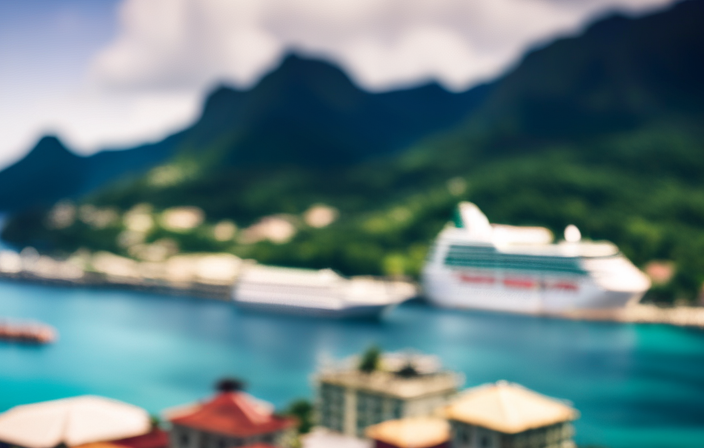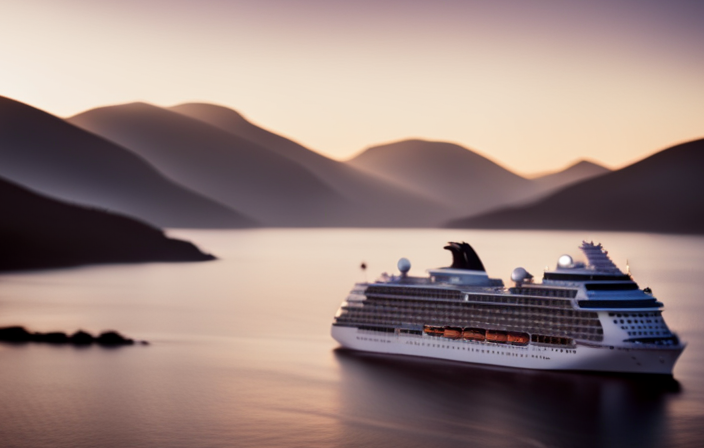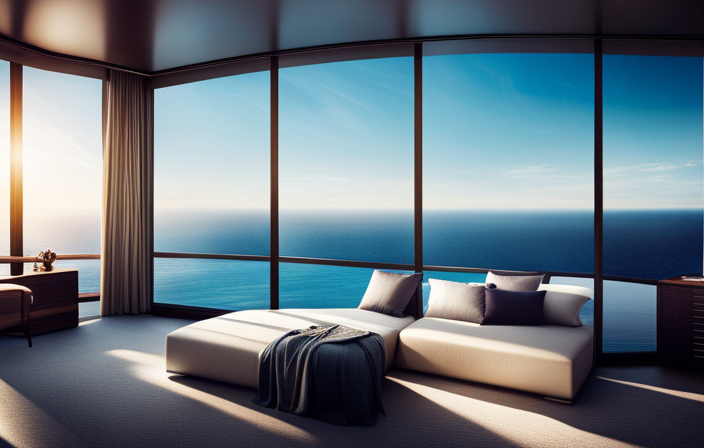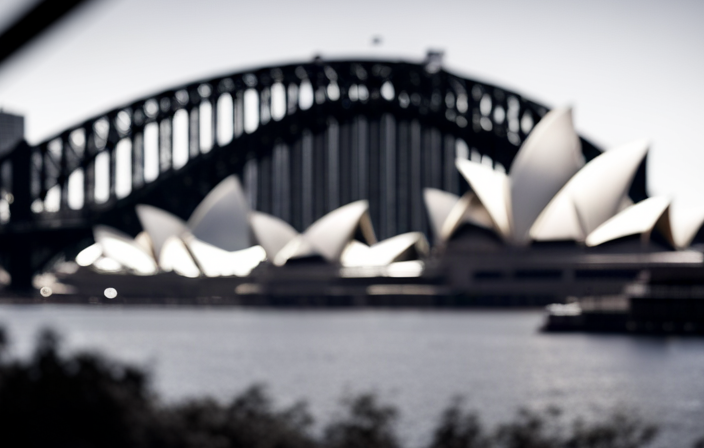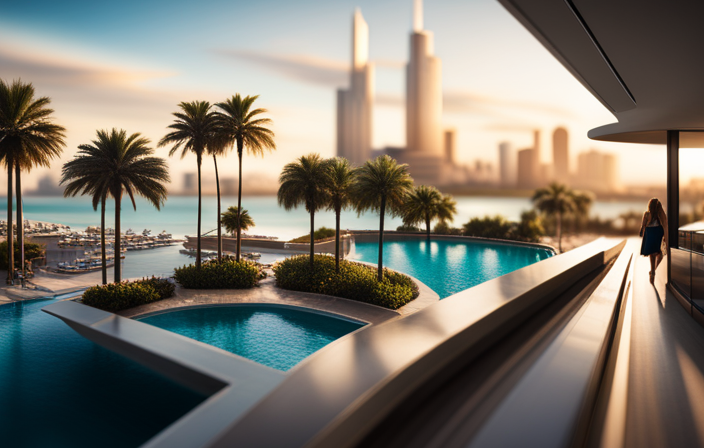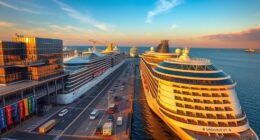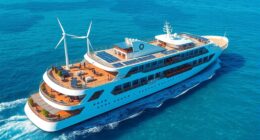Ah, the enchanting allure of the boundless sea, the gentle sway of the ship beneath my feet, and the excitement of undiscovered destinations that lie ahead. Cruises, those splendid maritime sanctuaries of leisure and discovery, have captured the adventurous spirit of explorers for ages.
As I embark on this journey to explore the origins of these magnificent vessels, I am reminded of the great explorers of the past, who braved the unknown in search of new lands and riches. Just as they set sail on their daring expeditions, so too did the pioneers of cruise travel set out to create a new form of leisure and exploration.
In this article, we will delve into the fascinating history of cruise ships, uncovering the visionaries who invented this extraordinary mode of transportation. From the early forms of cruise travel to the birth of modern cruise ships, from the evolution of luxury cruising to the rise of popular cruising, we will trace the remarkable trajectory of these floating wonders.
So, join me as we embark on this voyage through time and discover the captivating story of who invented cruise ships.
Key Takeaways
- Wealthy individuals in the 19th century took extended pleasure voyages, but cruise travel was exclusive and catered to the elite, and not accessible to the general public.
- The birth of modern cruise ships can be traced back to the mid-19th century when steamships started offering pleasure cruises, and the SS Prinzessin Victoria Luise in 1900 marked the beginning of the modern cruise ship era with larger vessels, more amenities, and a wider range of destinations.
- The Titanic revolutionized cruise ship design in 1912, setting the standard for luxury travel with its fine dining, spacious accommodations, and lavish entertainment. It also introduced technological advancements that enhanced safety at sea.
- Affordable mass-market cruises, particularly led by Carnival Cruise Line, made cruising accessible to a wider audience, boosting tourism, creating jobs, and stimulating growth in related sectors. Carnival’s innovative approach, fleet of modern ships, and commitment to environmental initiatives have redefined the cruising experience.
Early Forms of Cruise Travel
Cruise ships have come a long way from their early forms of travel. In the early days, cruising was not as popular as it is now. The concept of leisurely sailing on a ship for pleasure began in the 19th century when wealthy individuals started taking extended voyages to exotic destinations.
These early forms of cruising were exclusive and catered to the elite. Passengers would spend weeks or even months on board, enjoying the luxurious amenities and exploring new places.
However, it wasn’t until the late 20th century that cruising became more accessible to the general public. The birth of modern cruise ships saw the introduction of larger vessels, more amenities, and a wider range of destinations.
With the advancements in technology and the increasing demand for leisure travel, the cruise industry has evolved into the thriving industry we know today.
The Birth of Modern Cruise Ships
Ahoy there! Picture yourself transported back to the golden era of ocean travel, where the concept of leisurely voyages across the vast blue expanse became a reality, forever changing the way we experience the wonders of the sea.
The birth of modern cruise ships can be traced back to the early forms of cruise travel, where steamships began to offer pleasure cruises in the mid-19th century. These early cruises were mostly short trips aimed at the upper class, providing a luxurious escape from the monotony of everyday life.
However, it was the introduction of the SS Prinzessin Victoria Luise in 1900 that truly marked the beginning of the modern cruise ship era. This German vessel was the first purpose-built cruise ship, designed solely for pleasure cruising.
With this innovation, a new era of ocean travel was born, setting the stage for the evolution of luxury cruising.
The Evolution of Luxury Cruising
When discussing the evolution of luxury cruising, it is impossible to ignore the impact of the Titanic. The introduction of this iconic ship in 1912 revolutionized cruise ship design, setting a new standard for elegance and opulence.
Additionally, the emergence of transatlantic liners during this time period brought forth a wave of luxurious amenities, enticing travelers with fine dining, spacious accommodations, and lavish entertainment options.
The introduction of the Titanic and its influence on cruise ship design
As you step on board the grand Titanic, you can’t help but be awestruck by the luxurious design and opulent features that would go on to influence cruise ship design for decades to come. The Titanic’s technological advancements and commitment to maritime safety set a new standard in the industry. Here are four key elements of the Titanic’s design that revolutionized cruise ships:
-
Double bottom hull: The Titanic had a double bottom hull, which provided an extra layer of protection against potential leaks or damage.
-
Watertight compartments: The ship was divided into watertight compartments, allowing for better control over flooding and increased chances of survival in case of an accident.
-
Advanced communication systems: The Titanic boasted state-of-the-art wireless communication systems, enabling faster and more efficient communication between the ship and the shore.
-
Lifeboats: The Titanic had a sufficient number of lifeboats, although not enough for all passengers. This tragedy highlighted the importance of an adequate supply of life-saving equipment on all future cruise ships.
With these advancements, the Titanic paved the way for the emergence of transatlantic liners and their luxurious amenities.
The emergence of transatlantic liners and their luxurious amenities
Get ready to be transported back in time to the era of grand transatlantic liners, where opulence and luxury were the order of the day.
These magnificent vessels, designed for transatlantic travel, boasted a wide array of luxurious amenities that catered to the wealthy and elite. From lavish staterooms and exquisite dining options to lavish ballrooms and grand theaters, no expense was spared in creating an atmosphere of pure indulgence.
Passengers could enjoy leisurely days on deck, taking in the breathtaking ocean views, or partake in a variety of activities such as swimming, tennis, and even horseback riding.
The transatlantic liners truly set the standard for luxury travel and epitomized the glamour of the time. As the popularity of these grand ships grew, they laid the foundation for the rise of popular cruising, leading to even more innovative designs and unforgettable experiences.
The Rise of Popular Cruising
The rise of popular cruising has had a profound impact on the travel industry. Affordable mass-market cruises have made cruising accessible to a wider audience, leading to a surge in popularity.
One company that played a pivotal role in this shift is Carnival Cruise Line, known for its innovative approach to cruising. With their emphasis on fun, entertainment, and value for money, Carnival revolutionized the industry, making cruising a mainstream vacation option.
The impact of affordable mass-market cruises
Imagine stepping aboard a cruise ship, where affordable mass-market cruises have transformed the industry. The availability of affordable travel options has opened up cruising to a wider audience, allowing more people to experience luxury and adventure. The economic impact of these cruises has been immense. Ports of call have seen an increase in tourism, boosting local economies and creating jobs. The cruise industry has also stimulated growth in related sectors. Carnival Cruise Line has played a pivotal role in this transformation. By pushing the boundaries of what a cruise vacation can offer, Carnival has captured the imagination of travelers worldwide. Let’s delve into the role of Carnival Cruise Line and its innovative approach to discover the secrets behind its success.
The role of Carnival Cruise Line and its innovative approach
Step aboard a Carnival Cruise Line ship and let yourself be amazed by their innovative approach to cruising. Carnival Cruise Line has established itself as a dominant player in the cruise industry, offering a wide range of affordable mass-market cruises that cater to a diverse audience. With a fleet of modern and luxurious ships, Carnival has redefined the cruising experience.
Their innovative approach is evident in their commitment to environmental initiatives. Carnival has implemented numerous sustainability measures, including waste management systems, energy-efficient technologies, and the use of alternative fuels. These initiatives not only reduce the environmental impact of their operations but also create a more enjoyable and sustainable experience for passengers.
In addition to their environmental initiatives, Carnival Cruise Line has introduced several groundbreaking features to their ships, such as state-of-the-art entertainment venues, innovative dining options, and immersive onboard experiences. These innovations have set the stage for the future of cruise ship design, providing passengers with an unforgettable vacation experience.
As we delve into the next section about ‘innovations in cruise ship design,’ the influence of Carnival’s approach will become even more apparent.
Innovations in Cruise Ship Design
Cruise ships have made significant strides in incorporating sustainability initiatives and technology advancements into their ship designs. This includes the use of cleaner fuels to reduce emissions and the implementation of energy-efficient lighting and HVAC systems. Cruise lines are actively working towards minimizing their environmental impact.
Cutting-edge technologies such as advanced navigation systems, state-of-the-art entertainment options, and smart ship features have enhanced the overall guest experience on board.
As the demand for eco-friendly and technologically advanced cruise ships continues to grow, the industry is constantly pushing boundaries to create more efficient and sustainable vessels.
Looking ahead, the future of cruise ships will undoubtedly focus on further advancements in sustainability and technology. This ensures that passengers can enjoy unforgettable vacations while minimizing their carbon footprint.
The Future of Cruise Ships
As we look ahead, the future of cruising will undoubtedly bring us even more sustainable and technologically advanced vessels. Cruise ship companies are investing heavily in future technologies to enhance the passenger experience and minimize the environmental impact. One of the key focuses is on environmental sustainability, with ships being designed to reduce emissions and waste. Advanced propulsion systems, such as LNG (liquefied natural gas) and fuel cells, are being implemented to reduce greenhouse gas emissions. Additionally, cruise ships are incorporating energy-efficient systems and renewable energy sources like solar panels and wind turbines to decrease the reliance on fossil fuels. In terms of passenger comfort, cruise ships of the future will feature advanced amenities like virtual reality entertainment, artificial intelligence assistants, and smart cabins that adjust to individual preferences. The table below outlines some of the future technologies and environmental sustainability initiatives in cruise ship design:
| Future Technologies | Environmental Sustainability |
|---|---|
| Advanced propulsion systems (LNG, fuel cells) | Reduced greenhouse gas emissions |
| Energy-efficient systems | Decreased reliance on fossil fuels |
| Renewable energy sources (solar panels, wind turbines) | Minimized environmental impact |
| Virtual reality entertainment | Enhanced passenger experience |
| Artificial intelligence assistants | Increased operational efficiency |
The future of cruise ships is indeed promising, as the industry continues to prioritize sustainability and technological advancements to meet the growing demand for responsible and innovative travel experiences.
Frequently Asked Questions
How much does it cost to go on a cruise ship?
Going on a cruise ship can vary in cost depending on the options you choose. There are budget options available that allow for cost comparison, ensuring you find the best deal for your desired experience.
What are the most popular destinations for cruise ships?
The most popular destinations for cruise ships are the Caribbean, Mediterranean, and Alaska. Cruise ship safety is a top priority, with rigorous safety measures and trained staff. Entertainment options on board are diverse and cater to all interests.
How long do cruise ships typically stay at each port of call?
Cruise ships typically stay at each port of call for around 6-10 hours, depending on port regulations and the itinerary. Port expenses, such as docking fees and passenger taxes, also play a role in determining the duration of the stay.
What are some common amenities and activities available on modern cruise ships?
On modern cruise ships, the entertainment options are out of this world! From Broadway-style shows to jaw-dropping acrobatic performances, there’s something for everyone. And when it comes to dining, the variety of cuisines and dining options is simply incredible.
Are cruise ships environmentally friendly?
Cruise ships have a significant impact on marine life due to pollution and habitat destruction. To reduce their environmental impact, measures taken include wastewater treatment, fuel efficiency improvements, and adopting sustainable practices like recycling and reducing single-use plastics.
Who Started the Concept of Disney Cruise Ships?
The oldest Disney cruise ship is the Disney Magic, which set sail in 1998 and introduced the world to the concept of Disney Cruise Ships. This innovative idea was born from the desire to bring the magic of Disney to the high seas, creating a unique vacation experience for families.
Conclusion
In conclusion, cruise ships have come a long way since their early beginnings. They have evolved and transformed the way we travel and experience the world. From humble beginnings as transportation vessels to the luxurious floating cities we see today, cruise ships have undergone constant innovations in design and technology. The future of cruise ships looks promising, with new advancements on the horizon. So, set sail and embark on an adventure like no other, where the world becomes your oyster and the possibilities are as vast as the open sea. Bon voyage!


